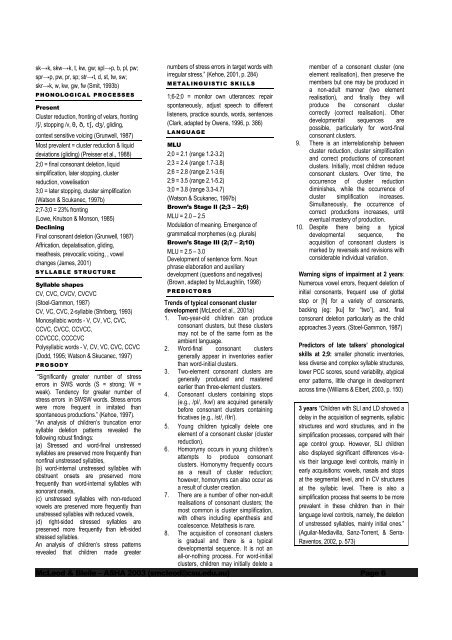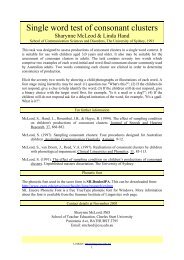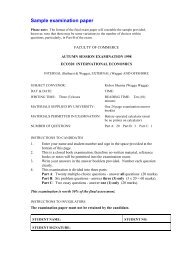Neurological and developmental foundations of ... - iVent Services
Neurological and developmental foundations of ... - iVent Services
Neurological and developmental foundations of ... - iVent Services
Create successful ePaper yourself
Turn your PDF publications into a flip-book with our unique Google optimized e-Paper software.
sk→k, skw→k, t, kw, gw; spl→p, b, pl, pw;spr→p, pw, pr, sp; str→t, d, st, tw, sw;skr→k, w, kw, gw, fw (Smit, 1993b)PHONOLOGICAL PROCESSESPresentCluster reduction, fronting <strong>of</strong> velars, fronting/S/, stopping /v, T, D, tS, dZ/, gliding,context sensitive voicing (Grunwell, 1987)Most prevalent = cluster reduction & liquiddeviations (gliding) (Preisser et al., 1988)2;0 = final consonant deletion, liquidsimplification, later stopping, clusterreduction, vowelisation3;0 = later stopping, cluster simplification(Watson & Scukanec, 1997b)2;7-3;0 = 23% fronting(Lowe, Knutson & Monson, 1985)DecliningFinal consonant deletion (Grunwell, 1987)Affrication, depalatisation, gliding,meathesis, prevocalic voicing, , vowelchanges (James, 2001)SYLLABLE STRUCTURESyllable shapesCV, CVC, CVCV, CVCVC(Stoel-Gammon, 1987)CV, VC, CVC, 2-syllable (Shriberg, 1993)Monosyllabic words - V, CV, VC, CVC,CCVC, CVCC, CCVCC,CCVCCC, CCCCVCPolysyllabic words - V, CV, VC, CVC, CCVC(Dodd, 1995; Watson & Skucanec, 1997)PROSODYnumbers <strong>of</strong> stress errors in target words withirregular stress.” (Kehoe, 2001, p. 284)METALINGUISTIC SKILLS1;6-2;0 = monitor own utterances: repairspontaneously, adjust speech to differentlisteners, practice sounds, words, sentences(Clark, adapted by Owens, 1996, p. 386)LANGUAGEMLU2;0 = 2.1 (range 1.2-3.2)2;3 = 2.4 (range 1.7-3.8)2;6 = 2.8 (range 2.1-3.6)2;9 = 3.5 (range 2.1-5.2)3;0 = 3.8 (range 3.3-4.7)(Watson & Scukanec, 1997b)Brown’s Stage II (2;3 – 2;6)MLU = 2.0 – 2.5Modulation <strong>of</strong> meaning. Emergence <strong>of</strong>grammatical morphemes (e.g. plurals)Brown’s Stage III (2;7 – 2;10)MLU = 2.5 – 3.0Development <strong>of</strong> sentence form. Nounphrase elaboration <strong>and</strong> auxiliarydevelopment (questions <strong>and</strong> negatives)(Brown, adapted by McLaughlin, 1998)PREDICTORSmember <strong>of</strong> a consonant cluster (oneelement realisation), then preserve themembers but one may be produced ina non-adult manner (two elementrealisation), <strong>and</strong> finally they willproduce the consonant clustercorrectly (correct realisation). Other<strong>developmental</strong> sequences arepossible, particularly for word-finalconsonant clusters.9. There is an interrelationship betweencluster reduction, cluster simplification<strong>and</strong> correct productions <strong>of</strong> consonantclusters. Initially, most children reduceconsonant clusters. Over time, theoccurrence <strong>of</strong> cluster reductiondiminishes, while the occurrence <strong>of</strong>cluster simplification increases.Simultaneously, the occurrence <strong>of</strong>correct productions increases, untileventual mastery <strong>of</strong> production.10. Despite there being a typical<strong>developmental</strong> sequence, theacquisition <strong>of</strong> consonant clusters ismarked by reversals <strong>and</strong> revisions withconsiderable individual variation.Warning signs <strong>of</strong> impairment at 2 years:Numerous vowel errors, frequent deletion <strong>of</strong>initial consonants, frequent use <strong>of</strong> glottalstop or [h] for a variety <strong>of</strong> consonants,backing (eg: [ku] for “two”), <strong>and</strong>, finalconsonant deletion particularly as the childapproaches 3 years. (Stoel-Gammon, 1987)Trends <strong>of</strong> typical consonant clusterdevelopment (McLeod et al., 2001a)1. Two-year-old children can produceconsonant clusters, but these clustersmay not be <strong>of</strong> the same form as theambient language.Predictors <strong>of</strong> late talkers’ phonological2. Word-final consonant clustersgenerally appear in inventories earlierskills at 2;9: smaller phonetic inventories,than word-initial clusters.less diverse <strong>and</strong> complex syllable structures,3. Two-element consonant clusters arelower PCC scores, sound variability, atypical“Significantly greater number <strong>of</strong> stressgenerally produced <strong>and</strong> masterederror patterns, little change in developmenterrors in SWS words (S = strong; W =earlier than three-element clusters.weak). Tendency for greater number <strong>of</strong>across time (Williams & Elbert, 2003, p. 150)4. Consonant clusters containing stopsstress errors in SWSW words. Stress errors(e.g., /pl/, /kw/) are acquired generallywere more frequent in imitated thanbefore consonant clusters containing3 years “Children with SLI <strong>and</strong> LD showed aspontaneous productions.” (Kehoe, 1997).fricatives (e.g., /st/, /Tr/).delay in the acquisition <strong>of</strong> segments, syllabic“An analysis <strong>of</strong> children’s truncation error5. Young children typically delete onestructures <strong>and</strong> word structures, <strong>and</strong> in thesyllable deletion patterns revealed theelement <strong>of</strong> a consonant cluster (clusterfollowing robust findings:simplification processes, compared with theirreduction).(a) Stressed <strong>and</strong> word-final unstressedage control group. However, SLI children6. Homonymy occurs in young children’ssyllables are preserved more frequently thanalso displayed significant differences vis-avistheir language level controls, mainly inattempts to produce consonantnonfinal unstressed syllables,clusters. Homonymy frequently occurs(b) word-internal unstressed syllables withas a result <strong>of</strong> cluster reduction;early acquisitions: vowels, nasals <strong>and</strong> stopsobstruent onsets are preserved morehowever, homonyms can also occur asat the segmental level, <strong>and</strong> in CV structuresfrequently than word-internal syllables witha result <strong>of</strong> cluster creation.sonorant onsets,at the syllabic level. There is also a7. There are a number <strong>of</strong> other non-adult(c) unstressed syllables with non-reducedsimplification process that seems to be morerealisations <strong>of</strong> consonant clusters; thevowels are preserved more frequently thanprevalent in these children than in theirmost common is cluster simplification,unstressed syllables with reduced vowels,with others including epenthesis <strong>and</strong>language level controls, namely, the deletion(d) right-sided stressed syllables arecoalescence. Metathesis is rare.<strong>of</strong> unstressed syllables, mainly initial ones.”preserved more frequently than left-sided8. The acquisition <strong>of</strong> consonant clusters(Aguilar-Mediavilla, Sanz-Torrent, & Serrastressedsyllables.is gradual <strong>and</strong> there is a typicalAn analysis <strong>of</strong> children’s stress patternsRaventos, 2002, p. 573)<strong>developmental</strong> sequence. It is not anrevealed that children made greaterall-or-nothing process. For word-initialclusters, children may initially delete aMcLeod & Bleile – ASHA 2003 (smcleod@csu.edu.au) Page 6





